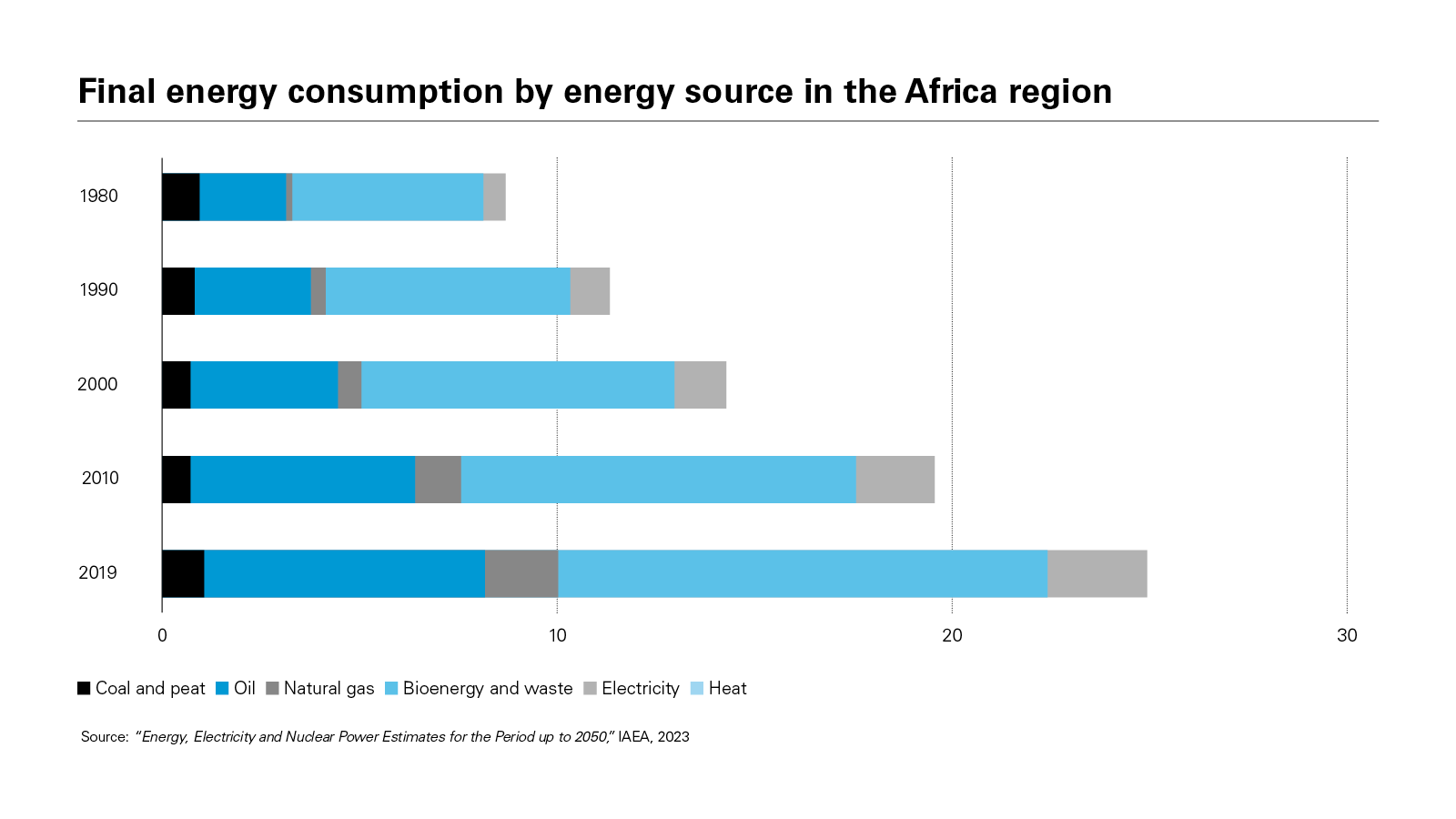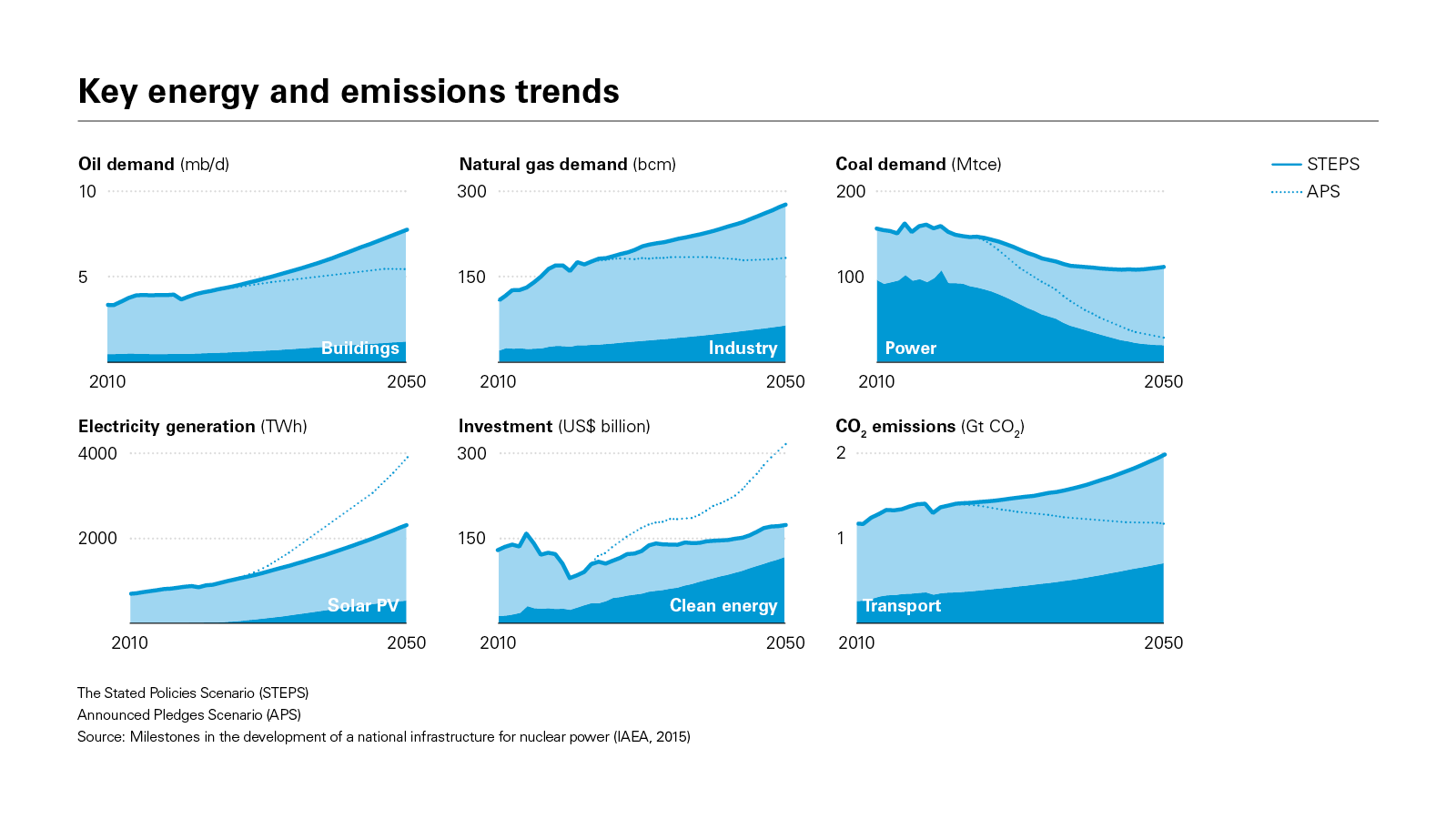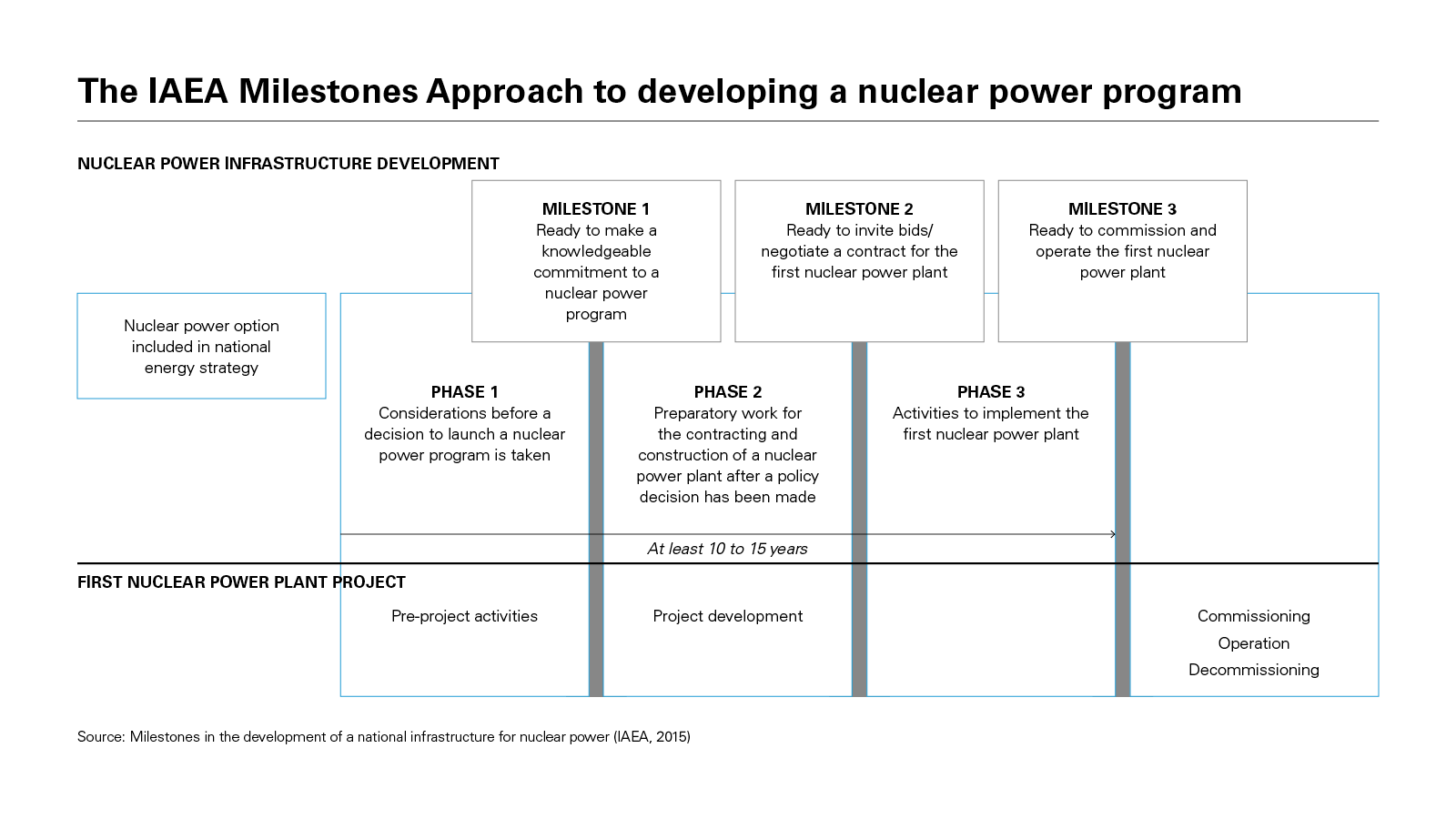Africa needs to significantly increase its electricity production to ensure universal access to its expanding population. It also needs to achieve net-zero emissions by 2050. Small modular reactors (SMRs) offer a potentially accessible and sustainable solution, but financing and regulatory hurdles must be addressed for widespread adoption.
Africa is in great need of energy: More than 40 percent of its population—approximately 600 million people—lacked access to electricity in 2022. That same year, 74 percent of the electricity was produced with fossil fuels, with low-carbon energies only producing 24.7 percent of the total electricity output (19 percent for hydro, 4.5 percent for wind and solar, and 1.2 percent for nuclear) according to the International Atomic Energy Agency (IAEA). Despite its substantial reliance on fossil fuels, Africa contributes only 2 to 3 percent of global carbon dioxide emissions from energy, as reported by the United Nations Framework Convention on Climate Change.
Electricity comprises a relatively small part of final energy consumption in Africa. The continent needs to significantly increase electricity production to ensure universal access to its expanding population (according to the United Nations, more than half of the global population growth between now and 2050 is expected to occur in that continent), while achieving its net-zero emissions target by 2050. The full transition to clean energy technologies will require more than doubling energy investments this decade, according to the IAEA. Nuclear will inevitably be part of the energy mix, together with other low-carbon energies, such as hydro, wind and solar, in order to achieve the big challenge ahead.
 View full image: Final energy consumption by energy source in the Africa region (PDF)
View full image: Final energy consumption by energy source in the Africa region (PDF)
The full transition to clean energy technologies in Africa will require more than doubling energy investments this decade
58%
Nuclear electrical generating capacity is projected to increase by 58% by 2030
Nuclear power and net-zero goals
According to the latest projections of the IAEA, the "total electrical generating capacity [for Africa] is expected to increase by 44 percent by 2030 and to undergo an almost four-fold increase by 2050. In the high case, nuclear electrical generating capacity is projected to increase by 58 percent by 2030 and to undergo more than a ten-fold increase by 2050 compared with 2022 capacity. In the low case, nuclear electrical generating capacity is projected to remain constant to 2030, and by 2050 it is expected to undergo close to a five-fold increase compared with 2022 levels."
Today, only two African countries have nuclear power programs: South Africa and Egypt. South Africa has two 970 MWe nuclear reactors, which started commercial operation in the 1980s and which output accounted for 4.9 percent of the electricity production in 2022. Egypt launched the construction of three 1,200 MWe reactors last year.
In 2007, the IAEA developed a comprehensive guide to assist newcomer countries in developing their nuclear power program in a sound manner: the IAEA Milestones Approach. The countries will have to go through three phases, which completion is marked by a specific milestone. The IAEA Integrated Nuclear Infrastructure Review (INIR) service monitors the progress made during the different phases and confirms whether a milestone has been achieved, as shown in the figure below. During the INIR missions, a holistic peer review is carried out by the IAEA and international experts to ensure that the country has set up the necessary infrastructure to develop a nuclear power program. It covers, among others, the national policies, the legal and regulatory regimes, the human resources capacity, the reliance of the electrical grid infrastructure, the potential sites that may be suitable to construct nuclear facilities and the supporting infrastructure.
African countries have shown a great interest in developing nuclear power. More than 26 percent of the INIR missions since 2009 have concerned African countries, such as Ghana, Kenya, Niger, Nigeria, Sudan and Uganda.
Two of them are currently in Phase 2 of the IAEA Milestones Approach: Ghana and Nigeria.
The nuclear sector is one of the most regulated industries, in order to ensure that nuclear technology, material, equipment and services will only be used for peaceful purposes in a safe manner, thus preventing their diversion and nuclear accidents. In its 70 years of history, there has been one case of diversion that led to a state acquiring nuclear military capability and three nuclear accidents with off-site damage. Each time, the international legal framework and guidelines have been reviewed to prevent such situations from recurring.
A country will need to ratify the conventions that form part of the international nuclear legal framework if it intends to develop a nuclear power program. As nuclear material is also used for non-power purposes (e.g., radioisotopes for medicine, industry or agriculture, and fuel for research reactors), most countries would already have ratified some of those conventions, and most certainly the Convention on Nuclear Safety and the Joint Convention on the Safety of Spent Fuel Management and on the Safety of Radioactive Waste Management. It is important however, that the conventions to which they are a party be duly incorporated into their national legal and regulatory framework, and that the key organizations are established (i.e., the governmental organization in charge of implementing the nuclear power program, the regulatory body and the owner/operator of the nuclear power plant).
 View full image: Key energy and emissions trends (PDF)
View full image: Key energy and emissions trends (PDF)
Regulatory strategies for widespread integration
The vendors of nuclear technology and the suppliers of nuclear material, equipment and services for a nuclear power plant will require that the legal and regulatory framework are consistent with the international nuclear conventions, especially with regard to nuclear liability and international guidelines (at least those of the IAEA). The international nuclear liability conventions provide that in case a nuclear incident occurs, the operator of the nuclear installation will be strictly and exclusively liable for any nuclear damage (e.g., loss or damage caused by radiation), and will only have a right of recourse to recover compensation paid for such nuclear damage against them "if and to the extent that it is so provided expressly by contract." For the vendors and suppliers, it is therefore key to ensure that such principles apply, and that the operator of the nuclear power plant will be the only entity to be held liable for such damage. It is important to note that vendors and suppliers will continue to bear the usual liabilities for non-nuclear damage, such as product liability.
Small and micro-modular reactors may be an alternative for countries to start building nuclear capacity, as their cost should be more accessible
The country interested in developing a nuclear power program will also need to enter into nuclear cooperation agreements (NCA) with those countries which organizations will be providing technology, nuclear material, equipment and services. NCAs provide the framework for bilateral cooperation in the nuclear field, ensuring that the recipient country will only use them for peaceful purposes and will meet the export policy requirements.
Small and micro-modular reactors as a sustainable solution
After setting up the domestic legal and regulatory framework, the government will need to prepare the relevant procurement structure, as well as the invitation to tender, which would imply that a decision has been taken with regard to the type of reactor that will be sought.
There are today a wide variety of reactors that should be able to address the different needs:
- Large reactors, with capacity beyond 700 MWe: The latest generation of large reactors is generally of 1,000 MWe at least
- Small modular reactors, with capacity from 10 MWe to 700 MWe: The Rolls-Royce version with a capacity of 470 MWe may be considered the largest
- Micro-reactors, with capacity of less than 10 MWe: the smallest being the MARVEL reactor of the Idaho National Laboratory in the US that will generate 100 kilowatts of power for various electrical and non-electric applications, such as thermal storage, water purification and district heating
Until now, only large nuclear power plants have been constructed around the world to provide electricity to the grid and have been mostly financed by public funds. However, some countries could struggle to finance such a capital-intensive technology, especially if/when multilateral financial institutions have not yet considered financing nuclear power projects.
Small and micro-modular reactors may be an alternative for countries to start building nuclear capacity, as their cost should be more accessible. This is partially due to the fact that they are "modular," meaning that they can be partially or fully manufactured in a factory and then assembled or directly installed on-site. Additional units may also be deployed to address potential increases in energy demand.
The majority of small and micro-reactors have been developed mainly for off-grid purposes (e.g., providing power or desalination capacity to isolated communities), and some have been specifically developed to decarbonize energy-intensive industries, such as chemicals, refining, mining, iron and steel. The advantages for an industrial site to be powered or receive heat from a small or micro-reactor are several: it will improve its footprint, as nuclear is a low-carbon energy; nuclear energy is reliable and not intermittent; with stable production costs, it will ensure a stable energy price; given the size and the new construction approach, the construction phase should be dramatically shorter than for a large nuclear power plant (expected to be at most five years for the largest SMRs), which would allow the vendor to be more easily on-time and on-budget; and most of all, it will provide the end-user with a long-term security of supply.
2–3%
Africa contributes only 2 to 3% of global carbon dioxide emissions from energy
If micro- or small modular reactors are to be used to decarbonize an industry, the latter may be able to finance them with minimal or no public funds. However, given the risks entailed with nuclear energy, the lenders or investors may certainly require some financial support from the state where the reactors will be located, and from the nuclear technology-exporting state through export credit arrangements or financial institution development loans.
Financing nuclear projects in Africa has become one of the major topics at the IAEA, the International Energy Agency and the OECD Nuclear Energy Agency, where calls for multilateral financial institutions to start financing nuclear projects have been made by those organizations, as well as governments and the nuclear industry. While all these stakeholders discuss potential solutions, the African countries that are interested in developing nuclear power programs should concurrently put in place the relevant legal and regulatory frameworks and ratify the required international conventions in order to be ready to continue the process once a financial scheme has been identified, and to allow the industry to use SMRs to decarbonize their activities and benefit from a reliable source of energy.
 View full image: The IAEA Milestones Approach to developing a nuclear power program (PDF)
View full image: The IAEA Milestones Approach to developing a nuclear power program (PDF)
[View source.]